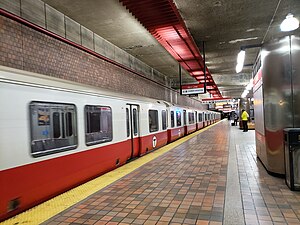
Back Metro de Boston Catalan MBTA subway Danish Metroo de Bostono Esperanto Metro de Boston Spanish Bostongo metroa Basque متروی امبیتیای Persian Métro de Boston French Metropolitana di Boston Italian MBTA 지하철 Korean Metro van Boston Dutch
| MBTA subway | |
|---|---|
 Red Line train entering Alewife station in November 2019 | |
| Overview | |
| Locale | Greater Boston, Massachusetts |
| Number of lines | 3 heavy rail (Red, Orange, Blue) 2 light rail (Green, Ashmont–Mattapan) 1 bus rapid transit (Silver) |
| Number of stations | 153 (list of stations) |
| Annual ridership | 85,397,200 (heavy rail, 2023) 34,581,000 (light rail, 2023)[1] |
| Website | mbta |
| Operation | |
| Began operation | September 1, 1897 (Tremont Street subway) |
| Operator(s) | Massachusetts Bay Transportation Authority (MBTA) |
| Train length | 6 cars (rapid transit) 1-3 cars (light rail) |
| Technical | |
| System length | 68.7 mi (110.6 km) – rail |
The Massachusetts Bay Transportation Authority (MBTA) operates rapid transit (heavy rail), light rail, and bus rapid transit services in the Boston metropolitan area, collectively referred to as the rapid transit, subway, or the T system.[2]
The color-branded lines consist of three heavy rail lines (Red, Orange, and Blue), one branched light rail system (Green), and a short light rail line (the Ashmont–Mattapan High-Speed Line, colored as part of the Red Line). All except the Ashmont–Mattapan line operate in tunnels in the downtown area, but no route operates entirely underground, and only 31 out of the system's 153 stations are located underground. The five branches of the Silver Line bus network are also shown as part of the rapid transit system. Three branches operate underground and charge rapid transit fares; two branches operate entirely on the surface and charge lower bus fares.
In 2023, the heavy rail lines had 85,397,200 rides,[1] or about 267,100 per weekday[3] in the fourth quarter of 2023, and comprised the fourth-busiest heavy rail system in the United States. In the same period, the light rail lines had 34,581,000 rides, or about 80,300 per weekday, and comprised the third-busiest light rail system in the United States.
The section of the Tremont Street subway between Park Street and Boylston Street stations, now on the Green Line, opened in 1897, making it the oldest transit subway in the United States still in use. (Only the short-lived Beach Pneumatic Transit demonstration line in New York City was built before.)
- ^ a b "Transit Ridership Report Fourth Quarter 2023" (PDF). American Public Transportation Association. March 4, 2024. Retrieved March 14, 2024.
- ^ "Ridership and Service Statistics" (PDF) (14th ed.). Massachusetts Bay Transportation Authority. 2014.
- ^ "Transit Ridership Report Fourth Quarter 2023" (PDF). American Public Transportation Association. March 4, 2024. Retrieved March 14, 2024.